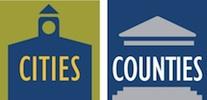Complete Streets
 In the past few decades, the design of California streets has largely been driven by motorist concerns and level of service standards. Complete streets are streets that are designed to accommodate all potential users – bicyclists, drivers, transit riders and pedestrians of all ages and abilities. Typical elements of complete streets include traffic calming to reduce speeds, urban greening, and bicyclist and pedestrian-oriented infrastructure.
In the past few decades, the design of California streets has largely been driven by motorist concerns and level of service standards. Complete streets are streets that are designed to accommodate all potential users – bicyclists, drivers, transit riders and pedestrians of all ages and abilities. Typical elements of complete streets include traffic calming to reduce speeds, urban greening, and bicyclist and pedestrian-oriented infrastructure.
Complete Streets Policies
Many local agencies are looking to complete street policies to boost the attractiveness of shopping streets. The general plan is a great place for local governments to introduce policies on complete streets. In order to provide complete streets, local governments may need to reexamine their level of service standards, zoning codes and parking standards.
Complete Streets Plans
Complete streets plans establish guiding principles for a community so that transportation improvements encourage walking, bicycling and transit use while promoting safe operations for all users.
Ideas/Role
In school zones, street design may integrate school colors or mascots. School officials can talk to cities and counties to propose unique street design treatments.
Examples:
Baldwin Park in Los Angeles County has a childhood obesity rate of 39 percent and decided to take action. The City of Baldwin Park passed a Complete Streets Policy (PDF) in which the city “will create a safe and efficient transportation system that promotes the health and mobility of all Baldwin Park citizens and visitors.” The policy:
- Establishes that the city will adopt Complete Street Design Guidelines for new and modified streets.
- Encourages the Baldwin Park Unified School District to also satisfy the policy.
- Establishes an inter-departmental advisory group to oversee the implementation of the policy.
The policy has helped the city gain access to Safe Routes to School funding.
The City of Sacramento adopted Pedestrian-Friendly Street Standards (PDF) to make streets more walkable. The standards include provisions like wider sidewalks, bike lanes and curbs to improve pedestrian and bicycle safety and encourage non-motorized transportation. The standards require traffic calming measures in new development areas including traffic circles, pedestrian islands and high-visibility sidewalks.
Related Links
- Complete Streets: Best Policies and Implementation Practices, American Planning Association
- Update to the General Plan Guidelines: Complete Streets & the Circulation Element, CA Governor’s Office of Planning & Research
- Complete Streets Implementation Action Plan, Caltrans
- Complete Streets Policy Analysis 2010: A Story of Growing Strength, National Complete Streets Coalition
- Complete Streets in California, National Complete Streets Coalition and Local Government Council
- Print-friendly




